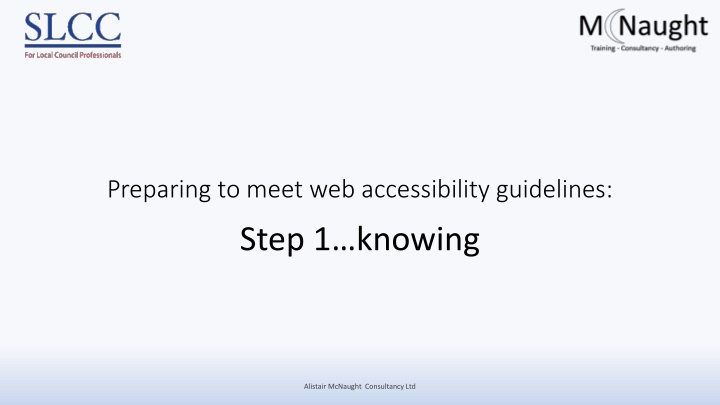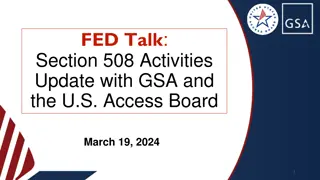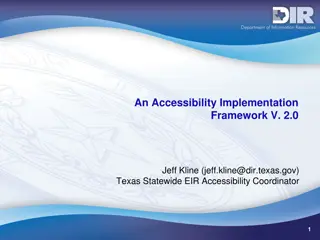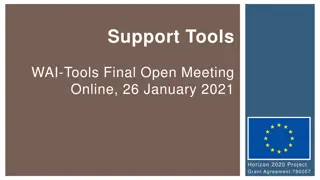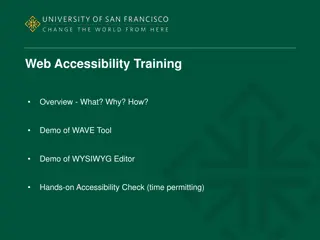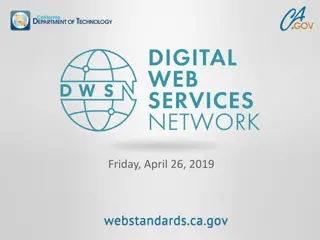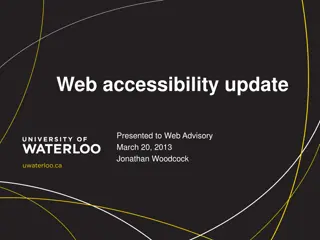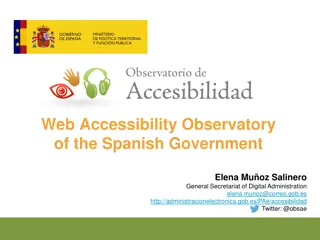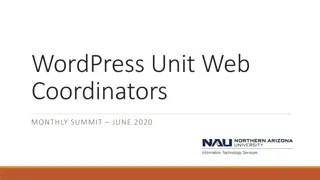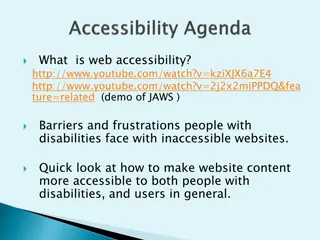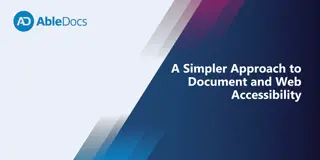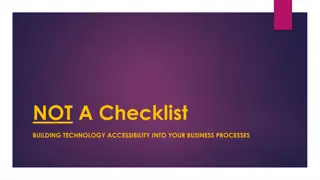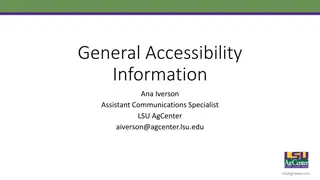Web Accessibility Guidelines Overview
The legislation and importance of web accessibility, emphasizing compliance deadlines for websites, along with disability prevalence and implications for web-based information. A focus on the principles of accessibility and the necessity of designing with inclusivity in mind to ensure equal access for all users.
Download Presentation

Please find below an Image/Link to download the presentation.
The content on the website is provided AS IS for your information and personal use only. It may not be sold, licensed, or shared on other websites without obtaining consent from the author.If you encounter any issues during the download, it is possible that the publisher has removed the file from their server.
You are allowed to download the files provided on this website for personal or commercial use, subject to the condition that they are used lawfully. All files are the property of their respective owners.
The content on the website is provided AS IS for your information and personal use only. It may not be sold, licensed, or shared on other websites without obtaining consent from the author.
E N D
Presentation Transcript
Preparing to meet web accessibility guidelines: Step 1 knowing Alistair McNaught Consultancy Ltd
Tell us your context (poll) 1. You outsource the website design and maintenance to others. 2. You create and maintain the website using a third party tool or online site. You don t do much code. 3. You are technically skilled and can design web sites from scratch 4. Other
The legislation in a nutshell Over riding principle = (i) stem the flow of new inaccessible content then (ii) tackle the legacy. 2019 Your website hasn t been updated since before 23 Sept 2018 In which case your website must comply by Sept 2020 Website Websites and active admin content need to be compliant by Sept 23rd 2019 2019 Content created after 2019 must comply but older active admin content needs to comply by Sept 2020. unless Documents published before 23 Sept 2018 are not in active admin use. Exempt. Office files But Video Must comply by Sept 2020, whether on new or old site.
Accessibility in 4 words and 1 phrase 4 words Perceivable Operable Understandable Robust The web is not a barrier to people with disabilities, it is the solution. However, for the web to reach its full potential for people with disabilities, web developers must commit to always designing with accessibility in mind. Failure to do so risks turning a revolutionary solution into yet another barrier in the lives of people with disabilities. 1 phrase Accessible to whom? Adapted from https://webaim.org/articles/pour/
Disability prevalence 11.6 m disabled people in UK, 5.7 million adults of working age, 5.1 million over state pension age Disability Vision Hearing Mobility Dexterity Learning difficulties Memory Mental health % Working age % pension age 11 8 44 24 18 23 68 34 14 8 16 32 17 9
Disability prevalence Implications for web based information Disability Vision Hearing Mobility Dexterity Learning difficulties Memory Mental health % Working age % pension age Implications for website design? 11 8 44 24 14 16 32 18 23 68 34 8 17 9 http://bit.ly/SLCCpart1
Your turn http://bit.ly/SLCCpart1
Anatomy of a user Key user techniques include: Magnify (CTRL +) Keyboard only navigation Navigation by headings Colour/contrast optimisation Text to speech (sighted) Screen reader (blind)
Follow up with others Using the chat pane, suggest some characteristics for some of your users. Age? IT awareness? How they ll access your website (phone/tablet/laptop)? Any disabilities or particular struggles?
Risk analysis Harder to test Screen readers and forms Screen readers and text Image descriptions Text to speech Works on phones Readability Heading structure Tab order Magnification & reflow Colour contrast Tab focus Easy to test Affects many in moderate way Affects few in a major way
Over to you Use Chrome or FireFox Load your website in a new browser tab. Work through some of the tests in the accompanying resource.
Anatomy of a website - 1 Structure, navigation and live content
Anatomy of a website core content Pages Navigation / site structure Responsive design Menus Hyperlinks (meaningful) Tab order, tab focus, skip links Image descriptions (or marking as decorative) Videos, controls, transcripts, subtitles Forms and form labelling for screen readers Downloadable content Documents print based forms.
Anatomy of a website - links Version 1 Sounds like To find out more about the planned digging up of the village pavements click here. The disruption will also affect phone lines. If you are disabled or housebound click here for alternative safety arrangements. click here click here Version 2 Sounds like To find out more about the planned digging up of the village pavements click here. The disruption will also affect phone lines. If you are disabled or housebound click here for alternative safety arrangements. planned digging up of the village alternative safety arrangements
Anatomy of a website - 2 Content for downloading PDF, Word etc.
Anatomy of a website PDFs and Word Either Explore the tabs on five things a PDF document should be able to do. Find a PDF on your website. Save it to the desktop. Open in Adobe Reader. How does it do? Or Find a video and see if you can control it without a mouse. Does it have a transcript or subtitles? Or Check if you can find any click here or here links that need changing. Or Check the readability of your content either online or downloadable.
Legislation revisited Are you failing to make a reasonable adjustment? Under the new legislation you need to Ensure your website meets accessibility standards and Publish a detailed accessibility statement based on the Government's model template - we'll explore this next session. You have until either Sept 2019 or Sept 2020 to comply, depending on whether your website is new or substantially changed since Sept 2018. Stem the "inaccessible" flow Budget for testing Involve others
Assessing priorities Context 1: You outsource the website design and maintenance to others. Is website accessibility in the contract or in your procurement processes? Which accessibility standards do your suppliers currently meet? Which standards do they know they don t yet meet? Is there an existing accessibility statement? How can they help you meet your obligation (or who else would be able to)?
Assessing priorities Context 2: You create and maintain the website using a third party tool or online site. You don t do much code. Do you know the accessibility credentials of the tool/site you use? Can you find out? Which of the following good practices do you follow on web content AND downloadable resources? Checking colour contrasts (including the contrast on followed links) Using heading styles for navigation, Using meaningful, unique hyperlink text, Describing images or (marking them as decorative) Checking readability.
Assessing priorities Context 3: You are technically skilled and can design web sites from scratch Do you develop content to the web accessibility guidelines? Do you exercise any quality control over content, including the following? Checking colour contrasts (including the contrast on followed links) Using heading styles for navigation, Using meaningful, unique hyperlink text, Describing images or (marking them as decorative) Checking readability. Do you know what your priorities will be now?
Task - 3 In the chat pane, thinking about your context, identify What you can influence, How you might influence it, Where you might get extra support, What your priorities might be.
Action planning Please add into the chat pane your intended actions as a result of this session: Practical things you can do on your own Policy things that require input, support or agreement from other people. Dissemination do you have other contacts in your networks who would benefit from coming to one of these sessions?
Part 2 Accessibility statements Using the content of this session to Start to write an accessibility statement that includes Benefits to users Issues and remedies Getting the processes in place Technical and testing Action planning
